INFORMATION BULLETIN
Trail, BC, May 22, 2020 - 4:00 p.m. PT
Evacuation orders in rural Grand Forks downgraded to alerts
- About a dozen Johnson Flats residents can return home but remain on evacuation alert until flood threat passes
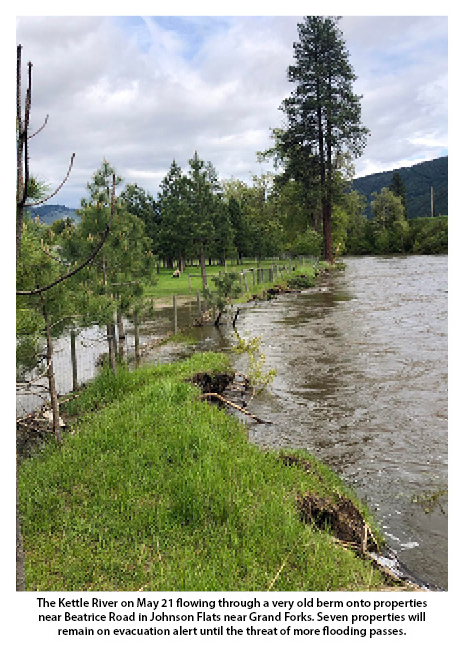
The Regional District of Kootenay Boundary Emergency Operations Centre (EOC) has informed residents in Johnson Flats near Grand Forks that they can return to their homes. Residents will remain on evacuation alert and must be ready to leave again at any time if the river rises through Sunday causing more flooding in the area.
The RDKB issued evacuation orders to six properties on Beatrice Street in the early hours of May 19 when the Kettle River breached an historic, unregulated berm, flooding two homes and cutting off access to four more.
A Ministry of Transportation and Infrastructure contract crew repaired water damage to Beatrice Street on May 21, and the RDKB has provided residents with a home re-entry package that includes information about best practices following an evacuation, and information about possible flood impacts to their homes or properties from the event. The RDKB will work with homeowners to assess damage to their homes or property and will follow up with homeowners to assist in recovery.
A total of 14 properties are on evacuation alert in the Boundary: seven in Johnson Flats and seven in Manly Meadows, all of which are in Electoral Area D / Rural Grand Forks. All properties will remain on alert until the threat of flooding has passed.
An evacuation alert means residents must be prepared to leave at any time, and all those on evacuation alert have received instructions on how to prepare including getting grab-and-go bags ready (which should include several days of clothing, toiletries and medications), reviewing their emergency plan, gathering copies of important documents and mementos, and arranging for alternate accommodation.
Current river forecasts show the Kettle River remaining at a one- to two-year return level, or typical freshet flows with another river peak possible on Sunday, May 24. Unsettled weather is expected to continue through the weekend giving way to clearer weather and warmer temperatures for the week of May 25. Low-lying areas will remain vulnerable to flooding if rainfall is high, and warming temperatures will further drive snowmelt at high elevations next week.
The RDKB continues to monitor all creeks and rivers and track BC River Forecast Centre model is maintaining its Emergency Operations Centre at a Level 2 in preparation for any emergency response that may be required.
The Regional District of Kootenay Boundary (RDKB) encourages residents to monitor low-lying areas for potential impacts from rising groundwater with some flooding as we move into the weekend
The High Streamflow Advisory issued by BC River Forecast Centre on May 6 remains in effect for the Boundary Region including the Kettle River, West Kettle River, Granby River and tributaries.
Sandbags and sand are currently available for residents in the following locations free of charge:
- Beaverdell behind the Fire Hall
- Westbridge Hall
- Riverside Centre in Rock Creek
- Grand Forks Arena
Residents must bring their own tools and equipment (shovels, transportation) and respect a physical distance of two metres (six feet) between workers as they fill sandbags.
Residents in the Boundary who are most at risk of flooding should stay informed about local freshet conditions, and ensure they have considered plans for moving valuable items, livestock or other items to safe locations if required. The RDKB also asks everyone to stay well away from the edges of creeks and rivers as banks become unstable during high water.
For more information about snow and river levels as well as how to prepare for the 2020 freshet, visit emergency.rdkb.com.
To register for the RDKB Emergency Alerting System go to https://ca.voyent-alert.com/vras/user-registration.html. The RDKB warns everyone to stay away from the edges of watercourses and report any erosion or flooding to the Provincial Emergency Coordination Centre at 1-800-663-3456.
The RDKB will continue to update the public as new information is available.
NEWS RELEASE
Trail, BC, May 20, 2020 - 3:00 p.m. PT
Kettle River levels to remain high but steady for coming days
- Six evacuation orders and nine evacuation alerts for rural Grand Forks to remain in place

The Regional District of Kootenay Boundary Emergency Operations Centre (EOC) is monitoring river levels for the next 48 hours to ensure conditions are safe before Beatrice Street residents in Johnson Flats near Grand Forks can return to their homes. Six properties on evacuation order and one on alert in Johnson Flats and eight properties on evacuation alert in Manly Meadows in rural Grand Forks will remain in place for now.
Current river forecasts show the Kettle River remaining at a one- to two-year return level, or typical freshet level, for the next number of days. Unsettled weather is forecast to continue, with patchy rain ranging from none to 10 millimetres, with rainfall possibly exceeding that in some locations. The river will remain high, and vulnerable to rising if rain exceeds forecasts.
The RDKB is now working on a re-entry plan for those residents who had to leave their homes in the early hours of May 19 due to encroaching water from the Kettle River into Johnson Flats. Several residents have remained in their homes.
“We are aware that it’s extremely stressful and disruptive, especially during this pandemic, to be asked to leave your home,“ said Mark Stephens, EOC Director.
Stephens said the EOC is working with RDKB building officials to assess possible damage to two homes, and with the Ministry of Transportation and Infrastructure who will repair damage to Beatrice Street, as well as damage to Manly Meadows Road where eight properties remain on evacuation alert due to their access threatened by the Kettle River.
“Our goal is to return residence safely to their homes as quickly as possible and we are working hard to make this happen.”
The RDKB continues to monitor all creeks and rivers and track BC River Forecast Centre model is maintaining its Emergency Operations Centre at a Level 2 in preparation for any emergency response that may be required.
The Regional District of Kootenay Boundary (RDKB) encourages residents to monitor low-lying areas for potential impacts from rising groundwater with some flooding as we move into the weekend
The High Streamflow Advisory issued by BC River Forecast Centre on May 6 remains in effect for the Boundary Region including the Kettle River, West Kettle River, Granby River and tributaries.
Sandbags and sand are currently available for residents in the following locations free of charge:
- Beaverdell behind the Fire Hall
- Westbridge Hall
- Riverside Centre in Rock Creek
- Grand Forks Arena
Residents must bring their own tools and equipment (shovels, transportation) and respect a physical distance of two metres (six feet) between workers as they fill sandbags.
Residents in the Boundary who are most at risk of flooding should stay informed about local freshet conditions, and ensure they have considered plans for moving valuable items, livestock or other items to safe locations if required. The RDKB also asks everyone to stay well away from the edges of creeks and rivers as banks become unstable during high water.
For more information about snow and river levels as well as how to prepare for the 2020 freshet, visit emergency.rdkb.com.
To register for the RDKB Emergency Alerting System go to https://ca.voyent-alert.com/vras/user-registration.html. The RDKB warns everyone to stay away from the edges of watercourses and report any erosion or flooding to the Provincial Emergency Coordination Centre at 1-800-663-3456.
The RDKB will continue to update the public as new information is available.
Trail, BC, May 19, 2020 10:00 a.m. PT
NEWS RELEASE
Six properties ordered to evacuate in Johnson Flats near Grand Forks
- High rainfall led Kettle River to cut off access for a cluster of homes on Beatrice Street
 At 1:30 a.m. this morning, emergency officials from the Regional District of Kootenay Boundary ordered six properties to evacuate when the Kettle River breached an illegally constructed berm, cutting off access to six homes in Johnson Flats near Grand Forks and may have damaged some structures. High rainfall in areas in the Boundary on May 17 and 18 led the Kettle River to peak overnight on May 18.
At 1:30 a.m. this morning, emergency officials from the Regional District of Kootenay Boundary ordered six properties to evacuate when the Kettle River breached an illegally constructed berm, cutting off access to six homes in Johnson Flats near Grand Forks and may have damaged some structures. High rainfall in areas in the Boundary on May 17 and 18 led the Kettle River to peak overnight on May 18.
No one has been injured and several of the fifteen residents affected have chosen to remain in their homes while others have left to stay with family or friends in the area.
“It’s always distressing for anyone who has to leave their homes on short notice, and we are doing everything we can as a regional district to address the needs these families will have over the coming week until they can return home. ESS Volunters with the Canadian Red Cross will be supporting affected residents while our EOC operations team assesses the situation,” said Mark Stephens, EOC Director.
Two more homes in Manly Meadows near Grand Forks were also placed on evacuation alert in addition to the seven homes placed on evacuation alert May 18 bringing the total to nine properties on evacuation alert in Manly Meadows and six on evacuation order in Johnson Flats in rural Grand Forks. Evacuation alerts may be followed by an immediate order to evacuate should conditions worsen.
“We’re really grateful for the support we received overnight from the City of Grand Forks Fire Department who were able to notify these residents quickly and make sure everyone was safe. The City of Grand Forks has been instrumental in our emergency operations centre and we have seen teamwork across our regional district with municipalities and electoral areas supporting one another to prepare for and respond to this freshet season,” said Diane Langman, RDKB Board Chair and lead of the EOC Policy Group.
While flood levels are still at a two-year return level —or at levels typically seen in a normal freshet year— changes to the river from catastrophic flooding in 2018 have altered flow patterns and eroded some areas that may not have seen flooding at existing river levels in past years. Water levels in the West Kettle, Kettle and Granby rivers are not forecast to surpass a two to five-year return level.
The RDKB continues to monitor all creeks and rivers and track BC River Forecast Centre model is maintaining its Emergency Operations Centre at a Level 2 for the next week in preparation for any emergency response that may be required.
The Regional District of Kootenay Boundary (RDKB) encourages residents to monitor low-lying areas for potential impacts from rising groundwater with some flooding as we move into the weekend.
The High Streamflow Advisory issued by BC River Forecast Centre on May 6 is still remains in effect for the Boundary Region including the Kettle River, West Kettle River, Granby River and tributaries.
Sandbags and sand are currently available for residents in the following locations free of charge:
- Beaverdell behind the Fire Hall
- Westbridge Hall
- Riverside Centre in Rock Creek
- Grand Forks Arena
Residents must bring their own tools and equipment (shovels, transportation) and respect a physical distance of two metres (six feet) between workers as they fill sandbags.
Residents in the Boundary who are most at risk of flooding should stay informed about local freshet conditions, and ensure they have considered plans for moving valuable items, livestock or other items to safe locations if required. The RDKB also asks everyone to stay well away from the edges of creeks and rivers as banks become unstable during high water.
For more information about snow and river levels as well as how to prepare for the 2020 freshet, click here.
To register for the RDKB Emergency Alerting System click here. The RDKB warns everyone to stay away from the edges of watercourses and report any erosion or flooding to the Provincial Emergency Coordination Centre at 1-800-663-3456.
The RDKB will continue to update the public as new information is available.
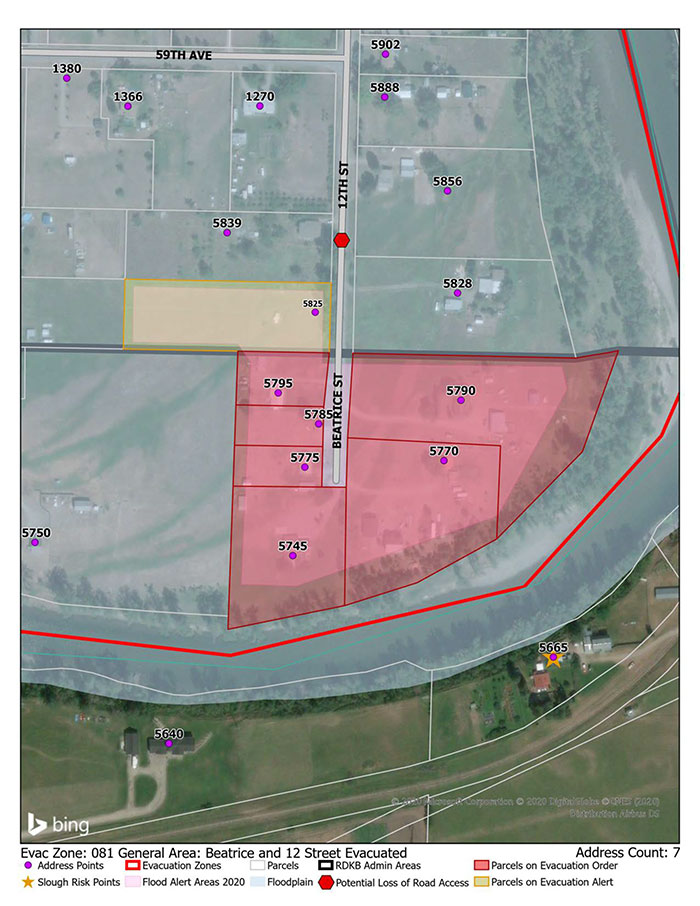
Evacuation alerts to seven properties in Manly Meadows near Grand Forks
- High waters could cut off access and flood low-lying areas as more rain falls
The RDKB Emergency Operations Centre (EOC) has issued evacuation alerts for seven properties in the low-lying Manly Meadows area of Electoral Area ‘D’/Rural Grand Forks due to the potential for loss of road access from rising Kettle River water levels. Residences of these properties listed in the attachment to this release are requested to be prepared to leave the area with very short notice.
The alert was issued to seven addresses in Edwards/Gilpin neighbourhood at midday today and affects about 18 people. Rainfall on May 17 and more rain forecast for the week of May 18 could cause flooding of low-lying areas and some properties could lose road access. Water levels are not expected to exceed those experienced in 2017. This alert may be followed by an immediate order to evacuate should conditions worsen.
The RDKB continues to monitor all creeks and rivers and track BC River Forecast Centre model, will have emergency staff available through the long weekend and maintain its Emergency Operations Centre at a Level 2 for the next week in preparation for any emergency response that may be required.
The Regional District of Kootenay Boundary (RDKB) encourages residents to monitor low-lying areas for potential impacts from rising groundwater and flooding as we move into next week. The High Streamflow Advisory issued by BC River Forecast Centre on May 6 is still remains in effect for the Boundary Region including the Kettle River, West Kettle River, Granby River and tributaries.
The RDKB continues to monitor all creeks and rivers and track BC River Forecast Centre model and is maintaining its Emergency Operations Centre at a Level 2 through the week of May 18 in preparation for any emergency response that may be required.
The Regional District of Kootenay Boundary (RDKB) encourages residents to monitor low-lying areas for potential impacts from rising groundwater with some flooding. The High Streamflow Advisory issued by BC River Forecast Centre on May 6 remains in effect for the Boundary Region including the Kettle River, West Kettle River, Granby River and tributaries.
Sandbags and sand are currently available for residents in the following locations free of charge:
- Beaverdell behind the Fire Hall
- Westbridge Hall
- Riverside Centre in Rock Creek
- Grand Forks Arena
Residents must bring their own tools and equipment (shovels, transportation) and respect a physical distance of two metres (six feet) between workers as they fill sandbags.
Residents in the Boundary who are most at risk of flooding should stay informed about local freshet conditions, and ensure they have considered plans for moving valuable items, livestock or other items to safe locations if required. The RDKB also asks everyone to stay well away from the edges of creeks and rivers as banks become unstable during high water.
For more information about how to safely sandbag during the COVID-19 pandemic, visit: https://www2.gov.bc.ca/gov/content/safety/emergency-preparedness-response-recovery/emergency-response-and-recovery/flood-response
For more information about snow and river levels as well as how to prepare for the 2020 freshet, visit emergency.rdkb.com.
To register for the RDKB Emergency Alerting System got to https://ca.voyent-alert.com/vras/user-registration.html.
The RDKB will continue to update the public as new information is available.


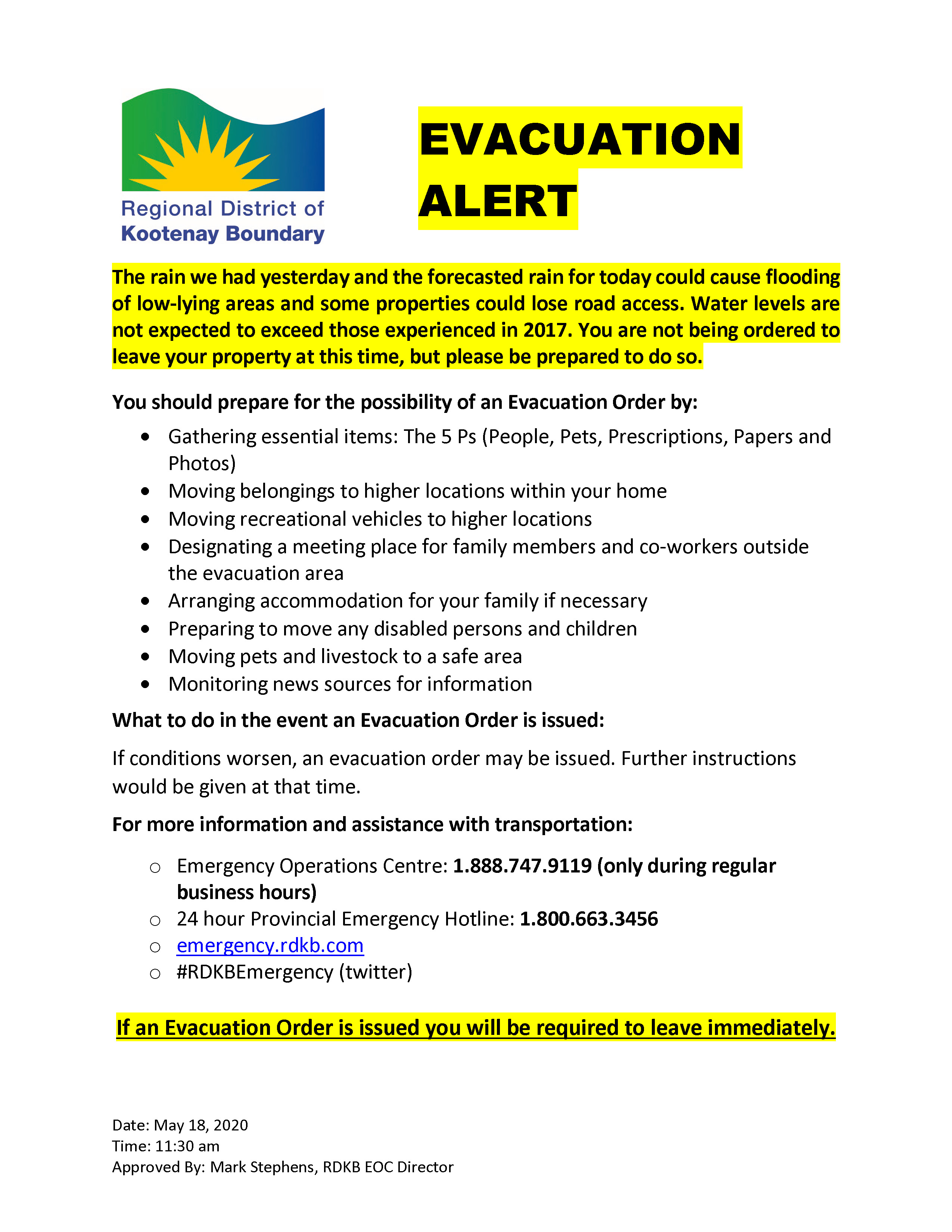
So far, so good – rivers high but flooding depends on rain
- - Long weekend thunderstorms unpredictable but flows expected to remain seasonal
The 2020 freshet continues with even higher flows in rivers and tributaries if rainfall predicted by Environment Canada exceeds the 10 to 30 millimetres forecast for the region. Unsettled weather is forecast to bring possible thunderstorms before Tuesday, May 19 when Boundary rivers will be close to their seasonal peak.
Rivers are expected to reach between a one and five year return based on current rain forecasts, which equates to an average to slightly above average freshet, but below 2017 levels that caused considerable low-elevation flooding, and well below 2018 levels that were catastrophic.
The RDKB continues to monitor all creeks and rivers and track BC River Forecast Centre model, will have emergency staff available through the long weekend and maintain its Emergency Operations Centre at a Level 2 through next week in preparation for any emergency response that may be required.
The Regional District of Kootenay Boundary (RDKB) encourages residents to monitor low-lying areas for potential impacts from rising groundwater with some flooding as we move into the weekend as the High Streamflow Advisory issued by BC River Forecast Centre on May 6 remains in effect for the Boundary Region including the Kettle River, West Kettle River, Granby River and tributaries.
Sandbags and sand are currently available for residents in the following locations free of charge:
- Beaverdell behind the Fire Hall
- Westbridge Hall
- Riverside Centre in Rock Creek
- Grand Forks Arena
Residents must bring their own tools and equipment (shovels, transportation) and respect a physical distance of two metres (six feet) between workers as they fill sandbags.
Residents in the West Boundary who are most at risk of flooding should stay informed about local freshet conditions, and ensure they have considered plans for moving valuable items, livestock or other items to safe locations if required. The RDKB also asks everyone to stay well away from the edges of creeks and rivers as banks become unstable during high water.
For more information about how to safely sandbag during the COVID-19 pandemic, visit: https://www2.gov.bc.ca/gov/content/safety/emergency-preparedness-response-recovery/emergency-response-and-recovery/flood-response
For more information about snow and river levels as well as how to prepare for the 2020 freshet, visit emergency.rdkb.com.
To register for the RDKB Emergency Alerting System got to https://ca.voyent-alert.com/vras/user-registration.html.
The RDKB will continue to update the public as new information is available.
May 13 - 2020 Freshet Update
River-watch continues in RDKB but no immediate flood threat
- Still potential impacts to low lying areas as groundwater expected to rise
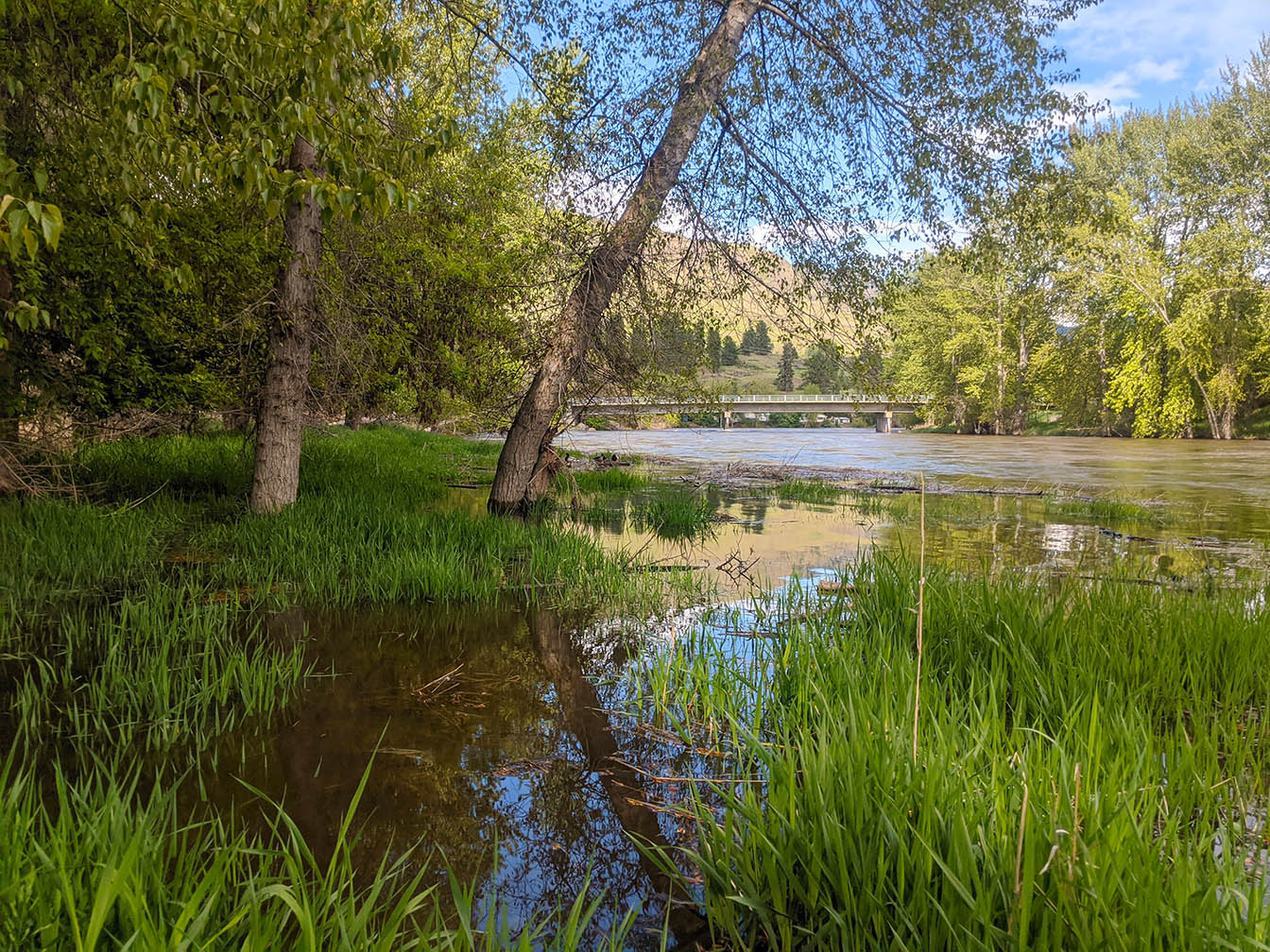
A shot from City Park in Grand Forks looking toward 2nd Street Bridge. Some normal riparian flooding visible in the foreground.
Major rivers and tributaries across the Boundary received minimal amounts of precipitation and experienced cooler temperatures creating favorable freshet conditions so far this week. Rain forecast overnight did not materialize but more unsettled weather is on its way.
Environment Canada predicts changeable weather conditions in our region through the May long weekend with potential for isolated to scattered showers and a risk of thundershowers, but this could change again in the next couple of days.
The RDKB continues to monitor all creeks and rivers and track BC River Forecast Centre models that show potential peak flows early next week through Monday and Tuesday.
The Regional District of Kootenay Boundary (RDKB) encourages residents to monitor low-lying areas for potential impacts from rising groundwater with some flooding as we move into the weekend.
Residents with homes and businesses in low-lying areas prone to flooding are encouraged to monitor their properties and basements for potential impacts for groundwater in particular.
The High Streamflow Advisory issued by BC River Forecast Centre on May 6 is still remains in effect for the Boundary Region including the Kettle River, West Kettle River, Granby River and tributaries. Sandbags are currently available for residents in the Westbridge and Beaverdell areas at the following locations free of charge:
- Beaverdell behind the Fire Hall
- Westbridge Hall
Residents must bring their own tools and equipment (shovels, transportation) and respect a physical distance of two metres (six feet) between workers as they fill sandbags.
Residents in the West Boundary who are most at risk of flooding should stay informed about local freshet conditions, and ensure they have considered plans for moving valuable items, livestock or other items to safe locations if required. The RDKB also asks everyone to stay well away from the edges of creeks and rivers as banks become unstable during high water.
For more information about how to safely sandbag during the COVID-19 pandemic, visit: https://www2.gov.bc.ca/gov/content/safety/emergency-preparedness-response-recovery/emergency-response-and-recovery/flood-response
For more information about snow and river levels as well as how to prepare for the 2020 freshet, visit emergency.rdkb.com.
To register for the RDKB Emergency Alerting System got to https://ca.voyent-alert.com/vras/user-registration.html.
The RDKB will continue to update the public as new information is available.
May 12 - 2020 Freshet Update
Sand and sandbags available in Westbridge, Beaverdell, Rock Creek
- Rain is forecast through mid-May
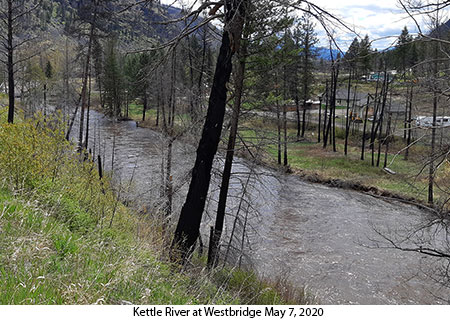 The Regional District of Kootenay Boundary wants residents in Westbridge, Beaverdell and Rock Creek to prepare for higher water levels in tributaries to the West Kettle River and possible flooding at low elevations. Environment Canada has issued a Special Weather Statement for southern B.C. with five to upward of 30 millimetres of rain forecast to fall unpredictably across the region for the next one to two days.
The Regional District of Kootenay Boundary wants residents in Westbridge, Beaverdell and Rock Creek to prepare for higher water levels in tributaries to the West Kettle River and possible flooding at low elevations. Environment Canada has issued a Special Weather Statement for southern B.C. with five to upward of 30 millimetres of rain forecast to fall unpredictably across the region for the next one to two days.
“We have identified the West Kettle system as a place to watch right now because we know from past storms this year that this drainage reacts to rainfall in the headwaters at Big White and at higher elevations above Christian Valley. Residents of all these West Boundary communities are going to see higher flows and we want anyone who is in those really low-lying areas to have access to sand and sandbags as we head into the weekend,” said Mark Stephens, Emergency Operations Centre Director for the RDKB.
Residents in the Westbridge, Beaverdell and Rock Creek areas can pick up sandbags and sand free of charge at the following locations:
- Beaverdell behind the Fire Hall
- Westbridge Hall
- Riverside Centre
Residents must bring their own tools and equipment (shovels, transportation) and respect a physical distance of two metres (six feet) between workers as they fill sandbags.
Stephens said emergency officials are also watching the main-stem Kettle River, but that it is slower to respond to brief rainfall events, and has more capacity overall. The RDKB could add a fourth sand pickup site in the Grand Forks area targeting only catalogued residences that typically flood in moderate flow years, and will make that decision based on forecasts early on May 13.
The RDKB is monitoring all rivers and creeks in the region and will update the response based on forecasts in the next 12 to 24 hours and update the public accordingly. Current BC River Forecast Centre models show that rivers will reach seasonal peaks in the Boundary within the next seven to ten days, depending upon weather.
“We can reassure Boundary residents that we don’t have the snowpack we had in 2018. With these sandbag sites open now, we want to be sure that residents have time to prepare for some possible flooding while maintaining physical distance from others,” said Stephens. “They may or may not see an actual need for those sandbags. Where and how much rain falls will determine that.”
Residents in the West Boundary who are most at risk of flooding should stay informed about local freshet conditions, and ensure they have considered plans for moving valuable items, livestock or other items to safe locations if required. The RDKB also asks everyone to stay well away from the edges of creeks and rivers as banks become unstable during high water.
For more information about how to safely sandbag during the COVID-19 pandemic, visit: https://www2.gov.bc.ca/gov/content/safety/emergency-preparedness-response-recovery/emergency-response-and-recovery/flood-response
For more information about snow and river levels as well as how to prepare for the 2020 freshet, visit emergency.rdkb.com.
To register for the RDKB Emergency Alerting System got to https://ca.voyent-alert.com/vras/user-registration.html.
The RDKB will continue to update the public as new information is available.
May 7 - 2020 Freshet Update
Our Freshet Advanced Planning Team spent May 7 in the field, and will be back to provide more information about forecasts and current river levels on May 8.
We encourage you to visit our Freshet Conditions page to see the latest, real-time river data and forecasts for the Boundary, from West Kettle River at Westbridge to the main-stem Kettle River at Ferry Washington to the Granby River outside of Grand Forks.
You can also visit the Boundary Integrated Watershed Service (BIWS) Facebook page for some excellent comparisons of 2017, 2018 and 2020 that were posted late today by a member of our Advanced Planning Team after returning from the field.
|
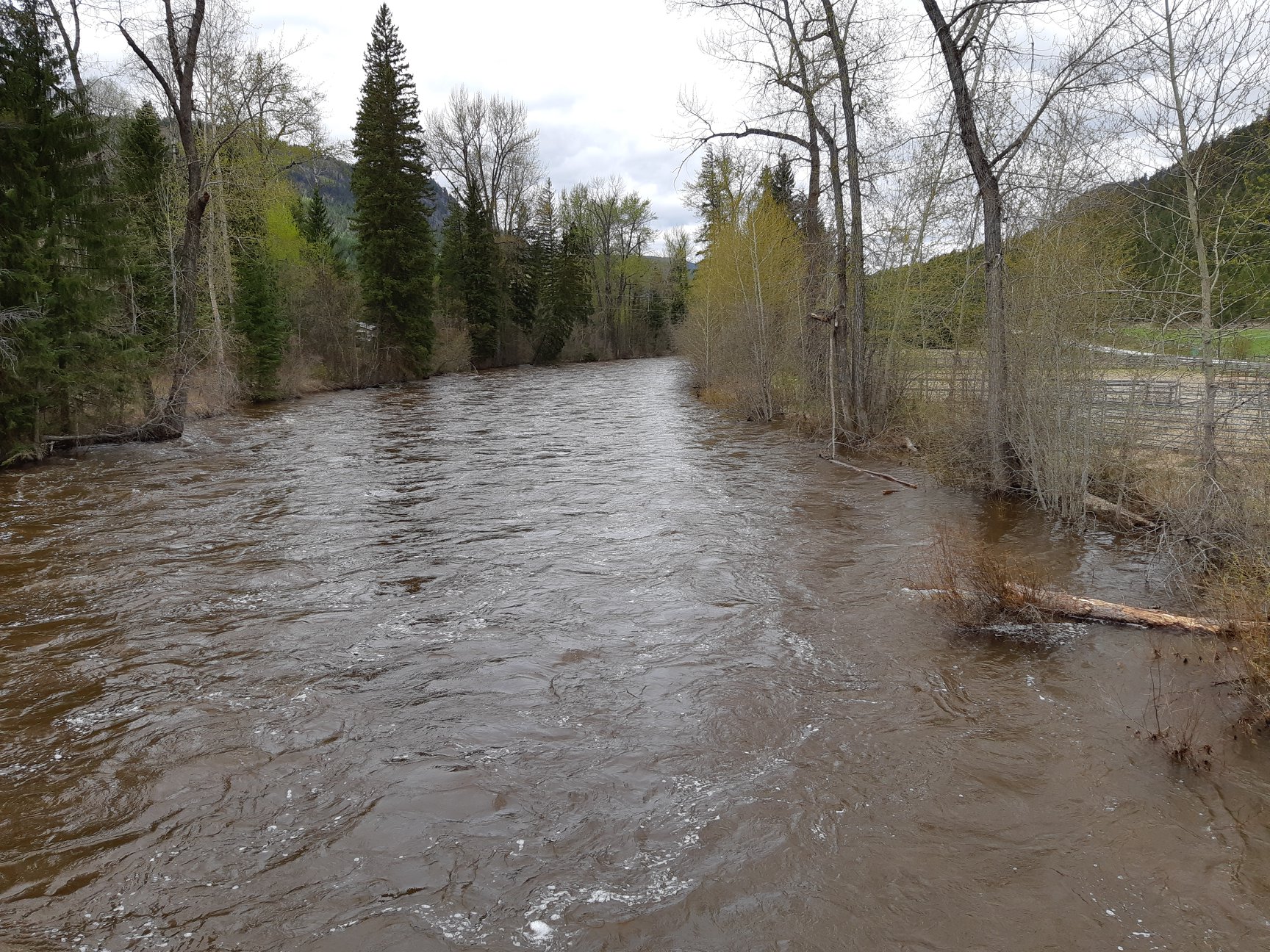
The West Kettle River on May 7, 2020.
|
May 6 - 2020 Freshet Update
NEWS RELEASE
Stay clear of fast-flowing rivers & creeks following High Streamflow Advisory
|
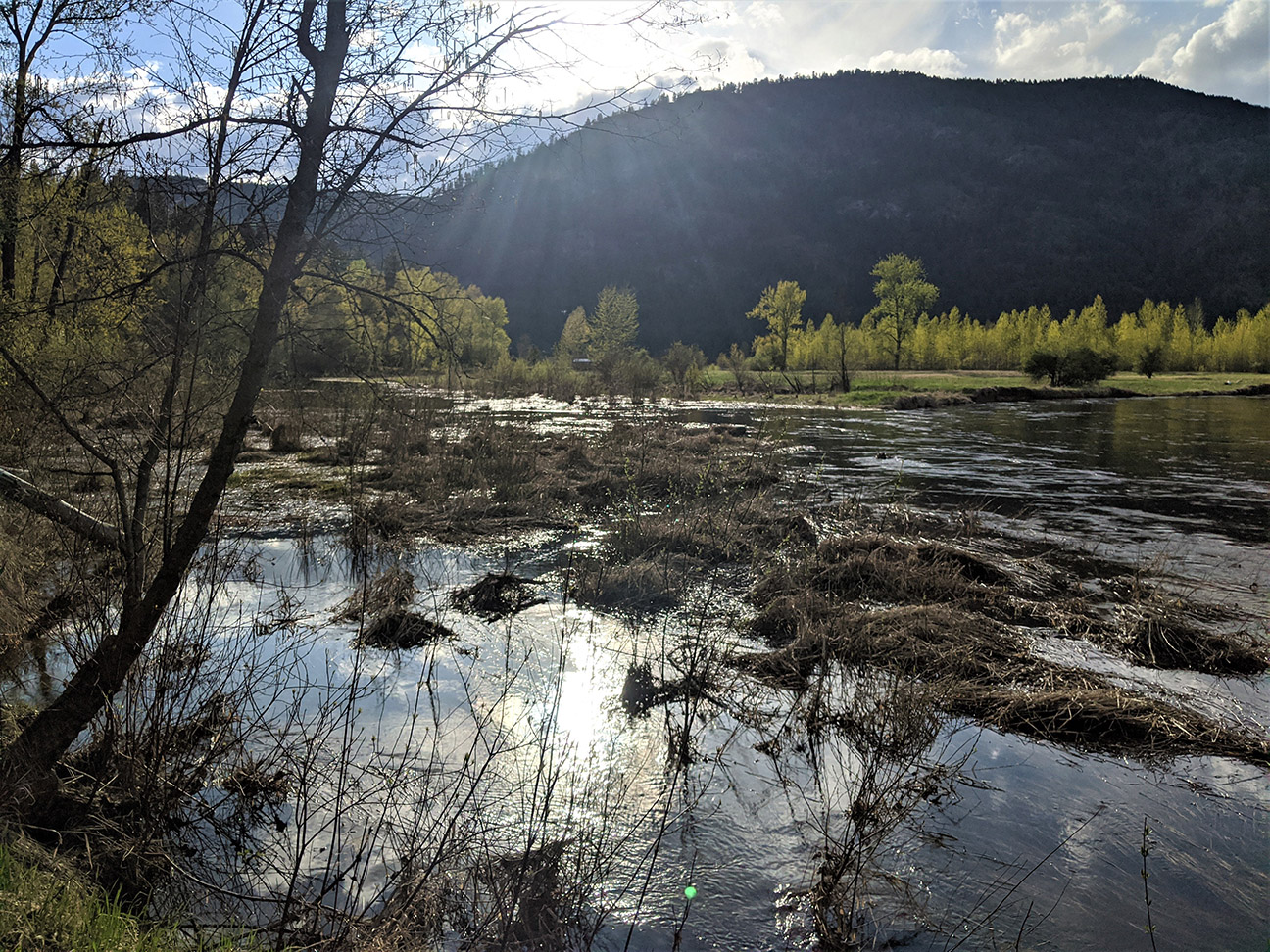 Typical low-level flooding in the Granby River near the near the Dam Site trail, May 5, 2020. Typical low-level flooding in the Granby River near the near the Dam Site trail, May 5, 2020.
|
The Regional District of Kootenay Boundary Emergency Operation Centre (EOC) is warning Boundary residents to be careful and stay clear of fast-flowing rivers and creeks. The BC River Forecast Centre issued a High Streamflow Advisory on the afternoon of May 6 indicating that water levels will rise in the next 24 to 48 hours with pockets of rainfall possible through the evening of May 6 in the mountains above the West Kettle, Kettle and Granby Rivers. Smaller streams and tributaries are running very high as a result of up to 30 millimetres of rain that fell across the Boundary region today.
The warning applies to tributaries and to the West Kettle, Kettle and Granby rivers. Erosion not visible above the water may cause banks to suddenly and unexpectedly collapse and debris to accumulate or dislodge at any time.
The potential for streamflow is in the 2-year to 5-year return period range, which means an average to slightly above average flow compared to a typical freshet season. Rises in water levels for larger rivers may happen as early as midday Thursday, May 7 and into Friday, May 8 with a period of higher flows expected over the weekend and into next week.
Major flooding is still not expected in the forecast period, but property owners with low-lying land should be taking care to have animals or vulnerable goods out of the low flood plain in case rivers rise further in the coming week. Property owners who see flooding in low-lying areas most years, or who typically have issues with spring groundwater are asked to remain vigilant. River levels are predicted to rise again with the arrival of warmer temperatures this weekend.
Farmers and others with rural property should check culverts and access roads for any damage due to the surge in smaller streams responding to the rainstorm. Building owners should check for localized drainage issues or water damage related to downspouts, roof maintenance or other site-specific concerns.
The RDKB has stockpiled 250,000 sandbags and our operations and logistics teams are poised to launch central sand pickup sites if river forecasts dictate a need.
The RDKB EOC in cooperation with Emergency Management BC and the City of Grand Forks has pre-positioned flood protection equipment including Tiger Dams™ (large, tubular bladders ready to be filled with water) and HESCO Floodline bins (large, flexible cubes ready to be filled with earth) in the City of Grand Forks. This equipment is a precautionary measure to ensure flood protection for major public infrastructure if required. It could be sent to other parts of the province at any time if it is needed more elsewhere.
For more information about snow and river levels as well as how to prepare for the 2020 freshet, visit emergency.rdkb.com.
To register for the RDKB Emergency Alerting System got to https://ca.voyent-alert.com/vras/user-registration.html.
To access the latest stream flow advisories and other information from the BC River Forecast Centre go to http://bcrfc.env.gov.bc.ca/warnings/advisories/flood_033.htm
The RDKB is monitoring all waterways and will assess freshet response needs on the morning of May 7 and provide an update then.
May 1 - 2020 Freshet Update
NEWS RELEASE
Subdued snowmelt means steady freshet for coming days
|
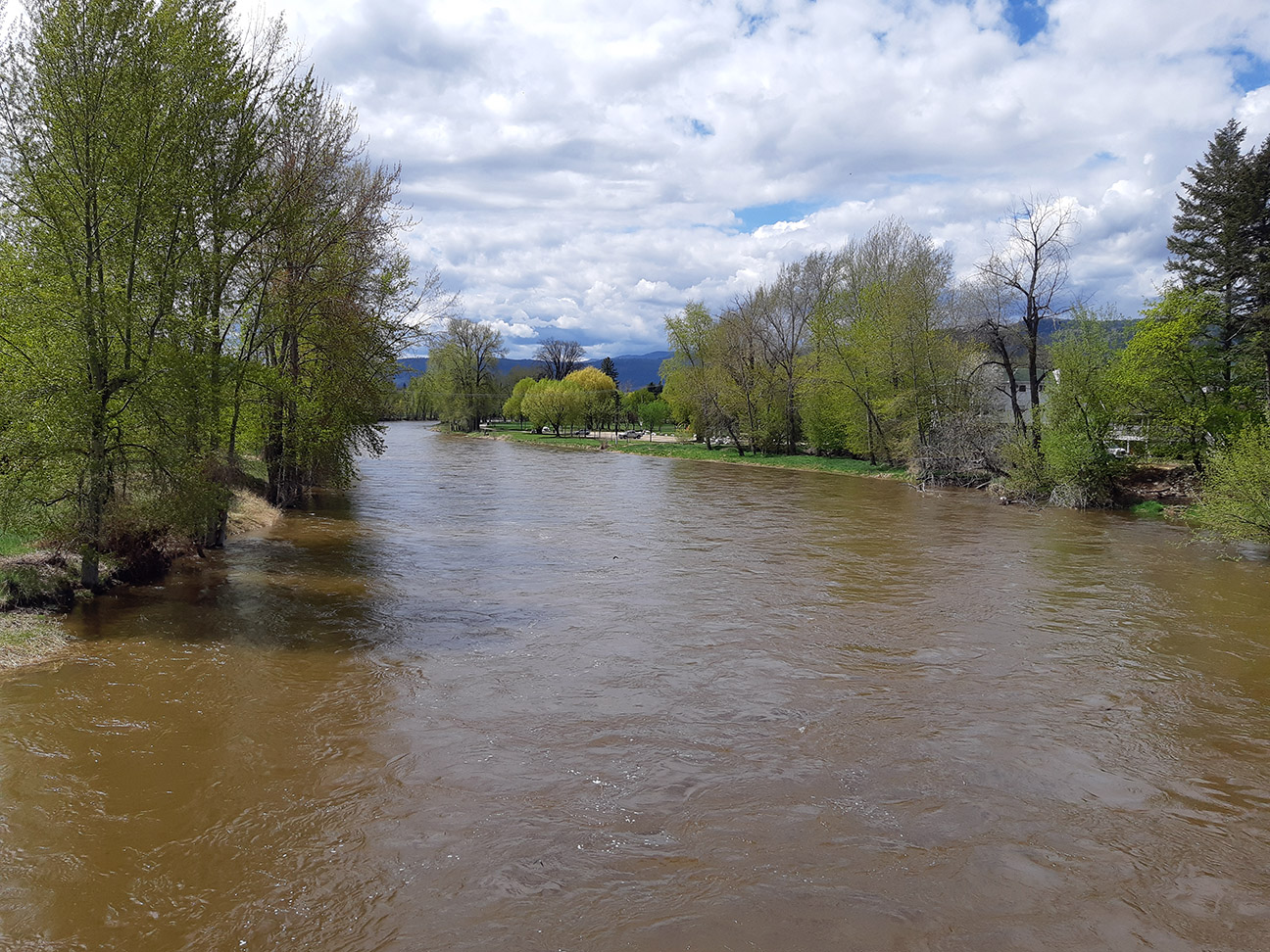 The Kettle River across from City Park in Grand Forks on May 1, 2020. Rivers in the Boundary are high, but expected to remain at stable levels for the coming days. The Kettle River across from City Park in Grand Forks on May 1, 2020. Rivers in the Boundary are high, but expected to remain at stable levels for the coming days.
|
An afternoon update to the Regional District of Kootenay Boundary Emergency Operation Centre (EOC) from the BC River Forecast Centre on May 1 will likely bring a measure of relief to Boundary residents for the short term. A slight rise in river levels by May 2 will yield to cooler weather with little rain, meaning a slower snowmelt and stable river levels for the next five days.
Boundary residents will see river levels rise on May 1 by midnight, then drop slightly after the weekend and start to rise again next week as temperatures again increase.
“With a trend toward cooler seasonal temperatures persisting through the weekend, our team feels pretty positive about the next week. We know that there is some rain coming, but all signs today are good – we’re well below any potential flooding levels compared to where we were at in 2017 or 2018 on this date,” said Mark Stephens, EOC Director for the RDKB.
The Boundary snowpack is currently at 119 per cent of normal compared to May 1, 2018 when snowpack was at 167 per cent of normal.
Stephens said the RDKB Freshet Advanced Planning team will continue to consult a variety of computer models and field readings daily to monitor river and creek levels and will provide their next public flood forecast the week of May 4 on the RDKB emergency website, emergency.rdkb.com.
“We are most concerned about any rain we could about a week from now, and of course we learned in 2018 that extreme weather can come on suddenly in a specific drainage or mountain range, but right now all trends show a fairly stable freshet for the next week,” said Stephens.
The RDKB has stockpiled 250,000 sandbags and will announce sand pick up locations if the situation changes.
The RDKB EOC in cooperation with Emergency Management BC and the City of Grand Forks has pre-positioned flood protection equipment including Tiger Dams™ (large, tubular bladders ready to be filled with water) and HESCO Floodline bins (large, flexible cubes ready to be filled with earth) in the City of Grand Forks. This equipment is a precautionary measure to ensure flood protection for major public infrastructure if required. It could be sent to other parts of the province at any time if it is needed more elsewhere. Residents who are at risk of flooding should stay informed about local freshet conditions, and ensure they have considered plans for moving valuable items, livestock or other items to safe locations if required. The RDKB also asks everyone to stay well away from the edges of creeks and rivers as banks become unstable during high water.
For more information about snow and river levels as well as how to prepare for the 2020 freshet, visit emergency.rdkb.com. To register for the RDKB Emergency Alerting System got to https://ca.voyent-alert.com/vras/user-registration.html.
The RDKB will continue to update the public as new information is available.
April 30 - 2020 Freshet Update
NEWS RELEASE
Higher flows expected in Kettle River system through the weekend
- Longer range predictions still uncertain, but slower melt favourable to date
The Regional District of Kootenay Boundary continues to watch rivers closely as they move toward peak flows anywhere from seven to ten days from now, depending upon weather. The Emergency Operations Centre (EOC) is activated to Level 2, with a Freshet Advanced Planning Team dedicated fulltime to river monitoring.
“Until we are closer to the weekend when river and weather forecast models enter the high confidence range, we won’t know which freshet scenario we are going to see, except to say that we are nowhere near what we saw in 2018. We could see one- to two-year return for river levels, and as always with high water could see some erosion,” said Mark Stephens, EOC Director for the RDKB.
Recent updates from the BC River Forecast Centre show that snowmelt will accelerate in early May as temperatures hit the low twenties and possible unsettled weather could bring rainfall at higher elevations. The amount of rain in combination with air temperatures will determine whether rivers in the Boundary reach typical freshet levels with minimal flooding.
“I have spoken with local directors and residents in the region and there is no doubt that this freshet is particularly stressful for many people in the Boundary. Not only are we all dealing with an ongoing pandemic, communities are still dealing with the impacts of the 2018 floods. We want to be sure that residents can prepare for whatever this freshet brings, while maintaining physical distance from others,” said Diane Langman, RDKB Chair and Lead for the EOC Policy Group.
The RDKB has stockpiled 250,000 sandbags and will announce sand pick up locations if the situation dictates a need. Sandbags and sand at these central sites would be free. Neither the RDKB nor the Province of BC will pay for sand ordered and delivered privately to any property in the region. The RDKB EOC in cooperation with Emergency Management BC and the City of Grand Forks will also pre-position flood protection equipment including Tiger Dams™ (large, tubular bladders ready to be filled with water) and HESCO Floodline bins (large, flexible cubes ready to be filled with earth) in the City of Grand Forks at the end of this week. This equipment is a precautionary measure triggered through the new Regional Flood Response Plan and ensures flood protection for major public infrastructure is available if required. Equipment will not be installed unless needed and could be redeployed to other parts of the province if needed elsewhere.
“As we approach our high water I would like to encourage residents to take the time and prepare by signing up for the RDKB evacuation alerting system and creating a personal or household preparedness plan,” said Stephens.
Residents who are at risk of flooding should stay informed about local freshet conditions, and ensure they have considered plans for moving valuable items, livestock or other items to safe locations if required. The RDKB also asks everyone to stay away from the edges of watercourses.
To watch a video presentation of the 2020 Freshet Outlook and for more information about snow and river levels as well as how to prepare for the 2020 freshet, visit emergency.rdkb.com. To register for the RDKB Emergency Alerting System got to https://ca.voyent-alert.com/vras/user-registration.html.
The RDKB will continue to update the public as new information is available.
APRIL 24 - 2020 Freshet Update
NEWS RELEASE
|
 The Granby River north of Grand Forks on April 19, 2020. The Granby River north of Grand Forks on April 19, 2020.
|
RDKB Emergency Program monitoring rivers and creeks across the region
- Residents advised to stay well clear of rising waters
The Regional District of Kootenay Boundary Emergency Operations Centre staff are tracking river and creek levels daily from Big White to Champion Lakes as snowmelt accelerates with warmer weather and rain. The regional snowpack is currently at 122% of normal.
“Most people in our region can see that water levels in our creeks, streams and rivers are rising. As this happens, erosion is possible and the riverbank can change rapidly. People need to stay back from the banks of fast moving water for their own safety,” said Mark Stephens, EOC Director for the RDKB.
Stephens said that RDKB staff measure water levels in the Kettle and Granby river system and in Christina, Boundary and Trail creeks daily, the RDKB EOC monitors all available data from river level sites, snowpack sites and weather stations within the Kettle and Granby watersheds in BC and Washington State. What staff have seen to date matches weekly data from the BC River Forecast Centre.
“We are watching the weather and snowmelt for the Kettle closely. We have definitely seen that transition into the melt season with mid-elevation and even high-elevation snow starting to come down. The West Kettle is currently at a one year return level and is forecasted to rise and fall throughout the next few days.” said Stephens.
The RDKB warns everyone to stay away from the edges of watercourses and report any major erosion or flooding to the Provincial Emergency Coordination Centre at 1-800-663-3456. Stephens added that the RDKB has a stockpile of 250,000 sandbags across the region, and will inform the public of local sand pickup sites if flood forecasts show a probability of localized flooding.Neither the RDKB nor the Province of BC will pay for sand ordered and delivered privately to any property in the region.
More information about snow and river levels as well as how to prepare for the 2020 freshet, visit emergency.rdkb.com.
-30-
—
APRIL 9 - 2020 Freshet Update
NEWS RELEASE
April snowpack lower than March, but still above normal
The snow basin index or the amount of snow in the mountains is 122 per cent of normal in the Boundary, a reduction of 12 per cent since March 1, and 118 per cent of normal in the West Kootenay, a reduction of four per cent.
“We are in a good weather trend right now with cooler nights and warm days, and if this keeps up for the next couple of weeks decline in snow levels at upper elevations, which will be in keeping with a normal freshet,” said Mark Stephens, Interim Manager of Emergency Programs at the RDKB and Emergency Operations Centre (EOC) Director.
The RDKB Emergency Program has been monitoring snowpack levels and weather conditions through out the winter. In spring, freshet risk assessments happen more often and are a core focus of both the Emergency Program and the EOC.
“The RDKB regional EOC has activated our advanced planning group within the EOC to help with the planning and analysis with the added lens of COVID-19”Stephens emphasized that shorter-term temperature variations and precipitation events can dramatically affect how the snow melts and runs off, and snow levels are still high.
The RDKB emergency program monitors snowpack, river levels and weather forecasts daily and communicates regularly with provincial staff at the BC River Forecast Centre and emergency program staff at Emergency Management BC. Emergency officials also play a key role in educating residents to prepare themselves for any emergencies that could occur in the region. Before the 2020 freshet, the Emergency Program encourages residents to do four things:
- Ensure that drains, culverts and other means of moving water away from residences remain clear as the snow continues to melt.
- Sign up to receive emergency evacuation alerts on a landline, mobile device or by email at emergency.rdkb.com or contact the RDKB directly at 1-800-355-7352 to get help signing up.
- Prepare by developing a household emergency plan, putting together a grab-and-go bag and connecting with neighbours. Emergencies teach us that knowing neighbours and developing a neighbourhood emergency plan can dramatically change how we fare in an emergency and how we recover afterwards.
- For those with river and lake front property that have experienced flooding in the past this is a good time to start planning flood protection for your household.
The RDKB Emergency Operations Centre is activated to a Level 2, which means multiple staff are dedicated to addressing both the 2020 freshet and the ongoing COVID-19 pandemic.
Information on current river and snowpack levels is available at emergency.rdkb.com.
More information about preparing for emergencies is available on the Prepared BC website: https://www2.gov.bc.ca/gov/content/safety/emergency-preparedness-response-recovery/preparedbc
–30–
The RDKB serves more than 31,000 residents in eight incorporated municipalities and five unincorporated electoral areas. The RDKB stretches across 8,200 square kilometres from Champion Lakes in the east all the way to Big White in the west. Our services include recreation and culture, planning, building inspection, environmental programs, economic development and public safety services for fire and other emergencies.
For more information:
Mark Stephens Interim Emergency Program Manager
250-368-0257
em@rdkb.com
Frances Maika Corporate Communications Officer
250-368-0233 or 250-231-3172
fmaika@rdkb.com
MARCH 30 - 2020 Freshet Update
NEWS RELEASE
THE RDKB Emergency Program continues to monitor the coming freshet season, through the COVID-19 crisis.
Freshet planning has been underway through the winter. RDKB EM staff have been monitoring snow accumulations and weather daily.
RDKB EM staff have had discussions with EMBC staff about freshet preparedness and what support will be available for local government and RDKB residents. The RDKB is reviewing our flood response plan and working with EMBC staff to determine what temporary flood protective works are available, when and if funding will be available to implement them, and other early response actions (like reaching out to available contractors). RDKB EM staff are working with local authorities to plan on-the-ground flood protection assessments, and plan to exercise our flood response plan in a few weeks’ time.
Special planning is being undertaken in response to physical distancing guidelines and how that might affect potential flood evacuations. All efforts would be made to avoid a physical reception centre and group lodging facility, with evacuees being helped over the phone or remotely.
Currently, automated snow pillow sites within or representative of the RDKB snow pack are reading as follows:
|
Site
|
Current Reading
|
Highest 2020 Reading
|
High Reading Date
|
|
Grano Creek
|
118%
|
134%
|
Feb 18 2020
|
|
Barnes Creek
|
134%
|
149%
|
Feb 10 2020
|
|
Mission Creek
|
134%
|
147%
|
Mar 13 2020
|
|
Sentinel Butte
|
119%
|
137%
|
Mar 18 2020
|
|
Redfish Creek
|
115%
|
141%
|
Jan 8 2020
|
Current weather forecasts are noted at Environment Canada. Warm days and cool nights are the best combination for a reasonable rate of snow melt. March has essentially been a best-case scenario as far as snow melt and less snow accumulation than normal.
The April Snow Conditions and Water Supply Bulletin will be released by the BC River Forecast Centre on April 8th, and we'll share that information when it's available.
For more information:
Chris Marsh Emergency Operations Centre Director 250-368-0259
Frances Maika Corporate Communications Officer 250-368-0233 or 250-231-3172
For more information about how to prepare for any emergency visit:
Province of British Columbia Emergency Preparedness
Federal Emergency Preparedness
RDKB prepares for 2020 freshet – asks residents to do the same
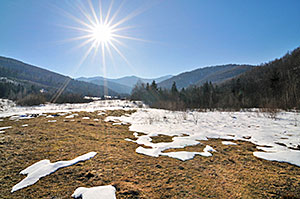 The BC River Forecast Centre has released the latest Snow Survey and Water Supply Bulletin, showing higher than normal levels for both the Boundary and West Kootenay snowpacks. The Boundary snowpack is at 134 per cent of normal, which is a six per cent increase since the last bulletin issued on February 1, 2020. The West Kootenay snowpack is at 121 per cent of normal, a decrease of five per cent since last reported.
The BC River Forecast Centre has released the latest Snow Survey and Water Supply Bulletin, showing higher than normal levels for both the Boundary and West Kootenay snowpacks. The Boundary snowpack is at 134 per cent of normal, which is a six per cent increase since the last bulletin issued on February 1, 2020. The West Kootenay snowpack is at 121 per cent of normal, a decrease of five per cent since last reported.
Regional snowpacks are only just starting to melt at lower elevations and snow could continue to accumulate at higher elevations even after spring officially arrives March 19.
The snow basin index is only one indication of flood risk. Shorter-term temperature variations and precipitation events can dramatically affect how the snow melts and runs off each spring.
“Though the snowpack is high right now in the Boundary, there are two and half months before our usual freshet is at its peak. If we see typical spring weather with warmer days and cooler nights continue, that snowpack has plenty of time to melt at a normal, steady rate. However, long-range forecasting is unpredictable so the only sound approach is to prepare,” said Mark Stephens, Interim Manager of Emergency Programs at the RDKB.
To prepare for whatever freshet scenario occurs, the Regional District of Kootenay Boundary has activated its Emergency Operations Centre to a Level 1. Two staff are monitoring the snowpack and freshet and planning for a possible flood event.
The RDKB has completed a comprehensive flood response plan and RDKB staff are working with partner agencies to hold readiness meetings and to review plans.
“We will keep working with our partners at Emergency Management BC and the BC River Forecast Centre to make sure we have the most up to date information to inform our decisions,” said Stephens.
The RDKB emergency program monitors snowpack, river levels and weather forecasts daily and meets regularly with provincial staff at the BC River Forecast Centre and at Emergency Management BC. Emergency officials also play a key role in educating residents to prepare themselves for any emergencies that could occur in the region. Before the 2020 freshet, the Emergency Program encourages residents to do four things:
1. Ensure that drains, culverts and other means of moving water away from residences remain clear as the snow continues to melt.
2. Sign up to receive emergency evacuation alerts on a landline, mobile device or by email at emergency.rdkb.com or contact the RDKB directly at 1-800-355-7352 to get help signing up.
3. Prepare by developing a household emergency plan, putting together a grab-and-go bag and connecting with neighbours. Emergencies teach us that knowing neighbours and developing a neighbourhood emergency plan can dramatically change how we fare in an emergency and how we recover afterwards.
4. For those with river and lake front property that have experienced flooding in the past this is a good time to start planning flood protection for your household.
The RDKB serves more than 31,000 residents in eight incorporated municipalities and five unincorporated electoral areas. The RDKB stretches across 8,200 square kilometres from Champion Lakes in the east all the way to Big White in the west. Our services include recreation and culture, planning, building inspection, environmental programs, economic development and public safety services for fire and other emergencies.
For more information:
Mark Stephens Interim Emergency Program Manager 250-368-0257
Frances Maika Corporate Communications Officer 250-368-0233 or 250-231-3172
For more information about how to prepare for any emergency visit:
Province of British Columbia Emergency Preparedness
Federal Emergency Preparedness